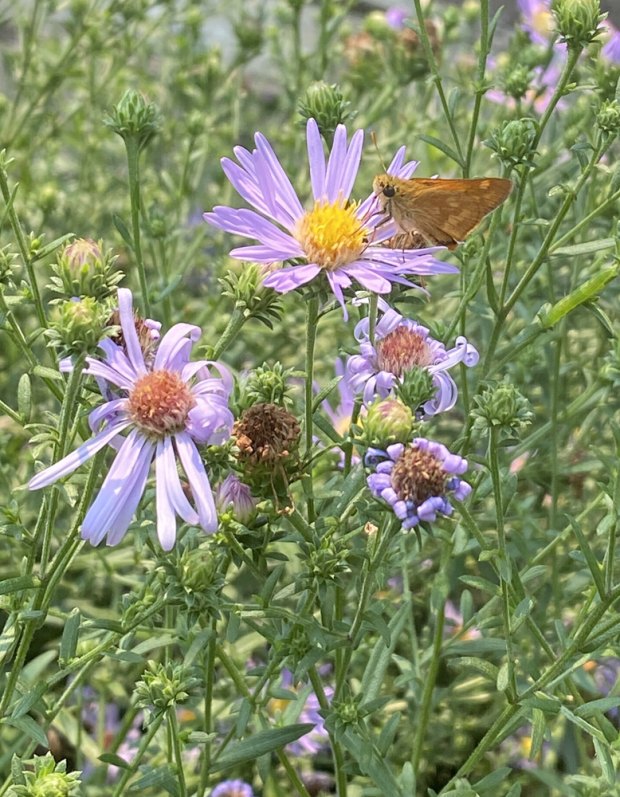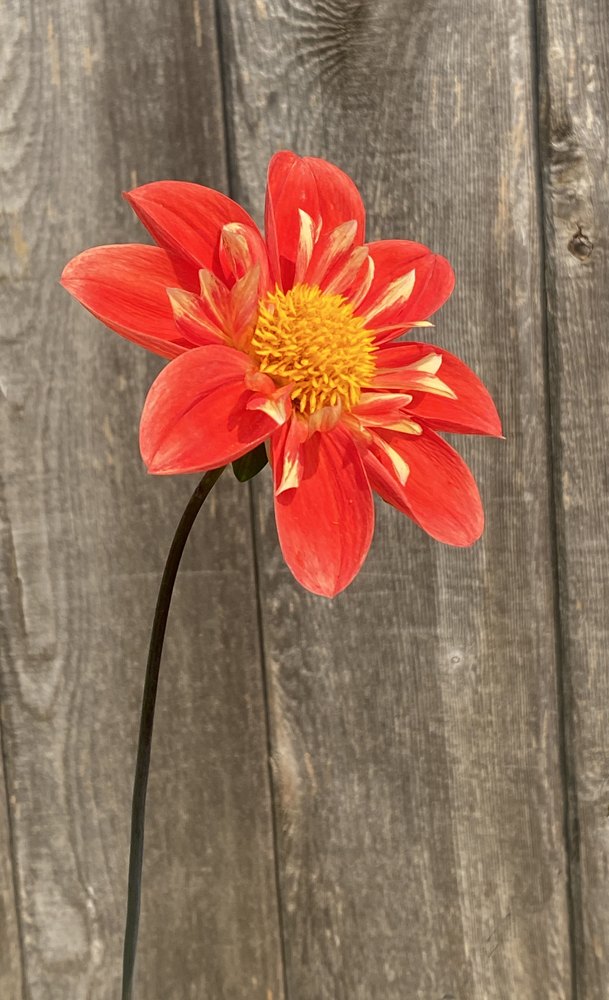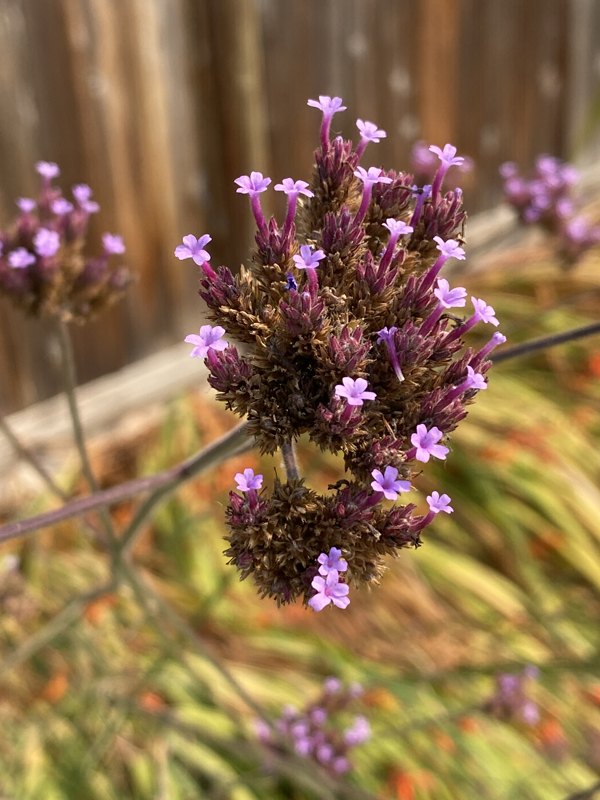
On a hot and hazy-blue day in mid-August, I ventured to the District of North Vancouver (DNV) for a Vancouver Master Gardeners tour of a Butterflyway Lane.
I wasn’t sure what to expect and it ended up setting my idea of gardening on its ear.Sally Hocking is an avid gardener, a landscape architect, a florist, chair of the Deep Cove Garden Club, and most recently, a Mentor Ranger in the David Suzuki Foundation (DSF) Butterflyway Project. In her Ranger capacity, Sally led five of us VMG members
on a thorough tour of this 200 m lane west of Ellis Street, between Dollarton Highway and Bournemouth Crescent. It’s on Google; check it out by clicking HERE
Each year since this Butterflyway Lane began in 2018, more of the neighbours with homes on Bournemouth Crescent or Dollarton Highway have joined in, converting their north- or south-facing back lane into a home for bees, birds, and butterflies. And for more than just Cabbage White butterflies—for West Coast Ladies, Painted Ladies, Pale Swallowtails, Western Tiger Swallowtails, and Woodland Skippers.
Becoming part of the David Suzuki Foundation Butterflyway Project is not just a simple matter of applying. DSF receives hundreds of applications each year and then provides successful applicants with materials and ongoing training, so eager participants must first convince the Foundation of their ability to grow habitat for local pollinators.
During Ranger Sally’s tour, I learned a set of guidelines that is different from the norm:
- Try for 70 percent of the biomass being native to the area—with a western redcedar in her backyard, Sally was already there; a Douglas-fir (Pseudotsuga menziesii), a western hemlock (Tsuga heterophylla), Scouler’s willow (Salix scouleriana), or other native shrubs, perennials, and grasses would also do.
- Allow flowers to go to seed—for self-seeding.
- Keep some fallen branches and roots for overwintering insects such as for solitary-bee nesting sites,
- Retain dead leaves, perennial stems, and grasses for pollinators to overwinter. If you must tidy up, just deadhead and leave the stalks standing, and bundle any cut stems against the fence as habitat.
- To feed and support the caterpillars of our native butterflies, grow some of their native host plants. For many butterflies, it’s not enough to get the genus right; be sure the species is local.
- Mostly provide only hands-off care to minimise disturbing the soil. For instance, do not rake as raking disturbs the habitat of solitary bees.
- Use NO or minimal amounts of fertilizer for many indigenous plants, which prefer a lower nutrient soil.
- Use NO pesticides, NO treated woods, NO daily watering—rescue watering applied early morning is okay in a heat wave depending upon the plant choices.
Some of the regular gardening rules are still at play:
- Install wood-panelled fencing as background—the DNV butterflyway received help from virgin fence-builders carrying out their TELUS Days of Giving volunteering. Those TELUS employees are now experts!
- Plant evergreen and deciduous shrubs for winter interest and permanence.
- Grow tall plants at the back—umbellifers and sun flowers, for instance.
- Chelsea chop (named for the Chelsea Flower Show) some plants for mid-height attraction and to extend the blooming period and nectar availability.
- Use local ground cover—such as woodland strawberries (Fragaria vesca) and wild strawberries (Fragaria virginiana) in the shade, and the shiny-leaved coastal strawberry (Fragaria chiloensis) in the sun.
- Mix plants for colour appeal.
- Read up about the local invasives, both flora and fauna.
- Don’t let invasive plants or aggressive weeds get a toehold. For example, remove dandelion, English ivy, and creeping buttercup.
- Alert the local authorities to any spots of noxious hogweed, knapweed, and knotweed so they can apply the appropriate pesticides.
- Keep stinging nettle for its appeal to insects—inside its own fence. It is a native host plant for five butterfly species, including Milbert’s Tortoiseshell, Satyr Comma, and West Coast Lady.
- Grow plants for Anna’s Hummingbird, such as Salvia microphylla ‘Hot Lips’ (a cousin of culinary sage). Grow hardy fuchsias and red-flowering currant to welcome back the Rufous Hummingbird in the spring.
Some of the plants that are doing well in the DSF Butterflyway Lane are these:
- yarrow (Achillea millefolium)
- fennel (Foeniculum vulgare)
- false forget-me-not (Brunnera macrophylla)
- oceanspray (Holodiscus discolor)
- Douglas asters (Symphyotrichum subspicatum)
- red-flowering currant (Ribes sanguineum)
- Shasta daisies (Leucanthemum × superbum)
- evergreen candytuft (Iberis gibraltarica ‘Betty Swainson’)
- purpletop vervain (Verbena bonariensis)
- wallflower ‘Bowles’s Mauve’ (Erysimum ‘Bowles’s Mauve’)
- sage ‘Caradonna’ (Salvia nemorosa ‘Caradonna’)
- wild mock orange (Philadelphus lewisii)
- love in a mist (Nigella damascena)
- honeysuckle, fuchsia, buddleia (both dwarf and sterile), wallflowers, nasturtiums, lemon balm, foxgloves, dahlias, sweet Williams, native woolly sunflowers, Pacific bleeding heart, phlox, dahlias, calendula, echinacea, rose campion, pearly everlasting, golden rod, black eyed Susan, cat mint, sedum, coreopsis, showy milkweed, narrow-leaved milkweed, columbines
- snowdrops, snow crocus, tulips, nodding onions, anemones
- and more and more
Beyond what would have been expected, there are many benefits to the creation of this butterfly lane in North Vancouver. It has brought the community together with lane parties, fence-building parties, children at play, Christmas tree decorating events, and after-work gatherings (distanced through Covid‑19). And with identification help from the Wild Bird Trust of British Columbia (a non-profit based in North Vancouver), there have been more local sightings of Ruby-Crowned Kinglets and Bewick’s Wren, thanks to the additional local habitat.
Vancouver Master Gardeners is involved in a number of gardening projects approved by the David Suzuki Foundation’s Butterflyway Project; for instance, at Ambleside, Riley Park, and soon, at Hycroft Manor, where three VMGs, including Julie Lucey, will be guiding University Women’s Club volunteers to convert some of that beautifully landscaped space into a new millennium, pesticide-free butterfly garden.
When we help the pollinators find their essential habitat, the returning butterflies,
birds, and bees are helping us find our way forward to our own sustainable West Coast gardening style.P.S. Master Gardeners are involved in supporting several butterflyway and pollinator initiatives in the Lower Mainland: Border Free Bees, Burkeville Community Food Program, Burnaby Nature House, Crescent Park Community Garden, Dr. Peter Centre Healing Garden, Edible Garden Project—School Program, Riley Park Community Garden, The Hycroft Manor Project, Paulik Park, Southlands Heritage Farm, West Vancouver Community Gardens and Pollinator Pathway at Ambleside, Women's Hospital—Heartwood Garden, and the potential for one at West Vancouver Memorial Library Rooftop Garden.
by Nina Shoroplova, Vancouver Master Gardener Student
For easier recognition in this article, birds’ and butterflies’ common names are capitalized. The common names of all plants on the other hand are lowercased.















